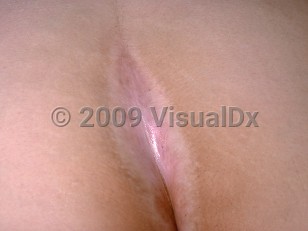Lichen sclerosus in Infant/Neonate
See also in: External and Internal Eye,AnogenitalAlerts and Notices
Important News & Links
Synopsis

Codes
L90.0 – Lichen sclerosus et atrophicus
SNOMEDCT:
895454001 – Lichen sclerosus
Look For
Subscription Required
Diagnostic Pearls
Subscription Required
Differential Diagnosis & Pitfalls

Subscription Required
Best Tests
Subscription Required
Management Pearls
Subscription Required
Therapy
Subscription Required
Drug Reaction Data
Subscription Required
References
Subscription Required
 Patient Information for Lichen sclerosus in Infant/Neonate
Patient Information for Lichen sclerosus in Infant/Neonate- Improve treatment compliance
- Reduce after-hours questions
- Increase patient engagement and satisfaction
- Written in clear, easy-to-understand language. No confusing jargon.
- Available in English and Spanish
- Print out or email directly to your patient



